
 |
Weather UpdatesAugust 8 - Pacific Ocean San Francisco Bay WeatherTo see what the winds are like on the Bay right now, check out http://sfports.wr.usgs.gov/wind/. California Coast WeatherLooking for current as well as recent wind and sea readings
from 17 buoys and stations between Pt. Arena and the Mexican
border? Here's the place - which has further links to weather
buoys and stations all over the U.S. Pacific Ocean WeatherCheck out the cloud pattern to the southwest of Cabo San Lucas. Looks like a hurricane because it is one. |
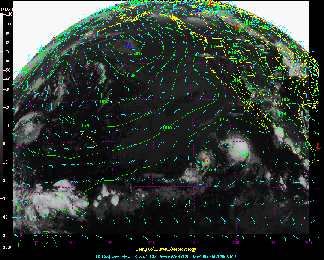 University of Hawaii Meteorology Graphic |
Seas are relatively normal in the North Pacific.
Check out http://www.mpc.ncep.noaa.gov/RSSA/PacRegSSA.html.
For another view, see http://www.oceanweather.com/data/global.html.
Hurricane Alberto in the Atlantic and Hurricane Gilma off Mexico
both continue with 70 to 80 knot winds. Like most Mexican hurricanes,
Gilma is headed out into the middle of the Pacific. Alberto, in
the Atlantic, continues to move east-northeast, which is good
news for both the Caribbean and the East Coast of the United States.
See http://weather.unisys.com/hurricane/atlantic/2000/index.html
and http://weather.unisys.com/hurricane/e_pacific/2000/index.html
for more.
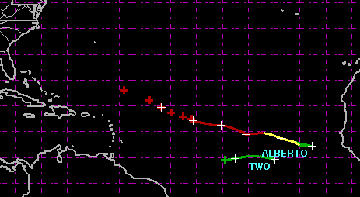 Hurricane Alberto |
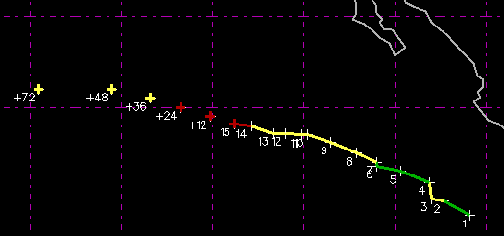 Hurricane Gilma |
After sailing in the '95 Ha-Ha aboard their Panda 38 'Pilgrim',
Steve Whitmore and Sue Angus of Pier 39 in San Francisco find
their circumnavigation has been going too fast. Currently, they
are in the Med where they describe the various anchoring techniques:
"For thousands of miles of sailing and anchoring, we have
always used the basic method advocated by Earl R. Hinz of Honolulu.
We put the anchor on the bottom, fall back slowly with the wind
or current, letting out chain as we go, then snub it off to set
the anchor. We reverse engine at medium RPM to check that we are
set, then open a can of beer and enjoy. But in the Med we have
observed new and exciting ways to anchor.
"Our favorite technique is the 'Metal Mountain Method'. The
anchor is put down, all the chain is dropped on top of the anchor,
and the bottle of wine is opened. But for sheer excitement, you
can't beat the 'Grand Prix' technique. In this one, you approach
your chosen anchor spot going at least five knots - although a
real pro will try for six or seven - and at precisely the right
moment you release your anchor and chain. Done properly, sparks
fly off the gypsy as the chain flies out and runs along the bottom
of your hull. With luck, the anchor will dig in before your boat
runs up on the beach, the bow will spin 180 degrees, and the boat
is set for the night. Exhilarating!
"Two techniques, however, make us nervous - and sometimes
even cause us to weigh anchor and move. They are the 'Saving for
a Windy Day' and 'Telephone Advertisement' techniques. In 'Saving
for a Windy Day', you put down as little chain as possible, keeping
most of it in the locker in case you will need it later. A scope
of two-to-one is all you need in this technique, so it's very
popular with crews on boats without windlasses. In the 'Telephone
Advertisement' technique, the idea is to get as close as possible
to at least one other boat, preferably close enough to 'reach
out and touch someone' if needed. This is also called the 'Gray
Poupon' technique and is popular with novice cruisers who are
worried about being by themselves. It's also popular with boats
not equipped with a depthsounder.
"Even though anchoring Med-style can be nerve-wracking, we
prefer it to Med-tying at the town quay - where one learns about
'anchor chain salad' - or as some call it, the 'Chinese chain
puzzle'."
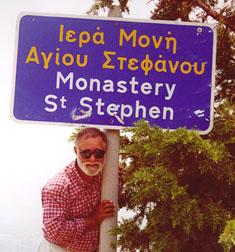 |
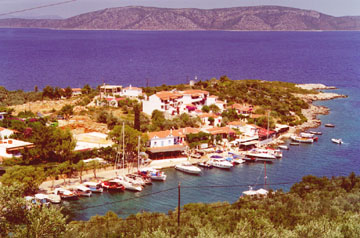 Photos
Courtesy 'Pilgrim' Photos
Courtesy 'Pilgrim' |
August 8 - The Pacific Ocean and Cyberspace
Who is out making passages in the Pacific and what kind of weather are they having? Check out YOTREPS - 'yacht reports' - at http://www.bitwrangler.com/yotreps/
August 8 - Hawaii
As we go to press, the 29-boat Kenwood Cup fleet is sailing the 150-mile Molokai Race, the last of the series. The Aussies hold a small lead over the Kiwis, who hope to repeat as champions. For more, check out the story and great photos at www.kenwoodcup.com.
The results of last Saturday's Santa Barbara to King Harbor
(Redondo Beach) Race have been posted along with a bunch of photos
at www.khyc.org. According
to Jeff Grance, who sailed aboard the Farr 40 'Groovederci', it
was a fast race. "It blew 8 to 10 knots at the start and
built to 18 to 20 knots just before Anacapa Island. Although it
was light behind Anacapa, by the time we got to Pt. Dume it was
blowing 30 knots - enough to let the the Farr 40 hit a sizzling
20.2 knots despite rather flat seas. The strong wind was also
responsible for one Roland 36 catamaran breaking a rudder and
another flipping. The crew of the flipped cat were rescued by
the Andrews 70 'Vicki'. With the wind holding at 15 to 18 knots
to the finish, the entire fleet completed the 81-mile course before
0200 - which may be some kind of a record."
Turning in fine performances in Class A were 'Pendragon 4' and
Bob Lane's Andrews 56 'Medicine Man', a couple of smaller sleds
that beat the 70s and bigger boats to take the top two spots in
class on both elapsed and corrected time. Mike Campbell's Schock
40 'Cincos', which won Class B, corrected out ahead of both of
them, but she in turn was beaten by a couple of Class D boats,
'Enamorada' and 'Pangea', which took the top corrected time honors
in the fleet.
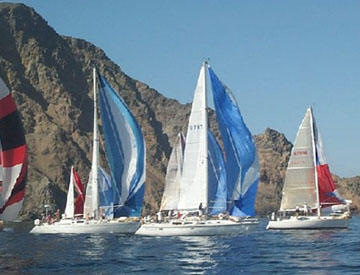 Wind-Stealing at Anacapa Island |
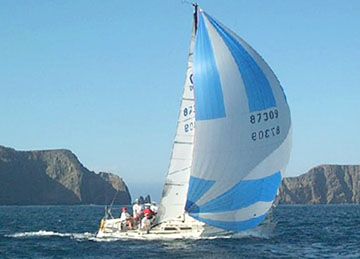 The Olson 30 'Priorities' has theirs straight. Photos Courtesy King Harbor Yacht Club |
Top / Index of Stories
/ Subscriptions
/ Classifieds
/ Home©2000 Latitude 38 Publishing
Co., Inc.